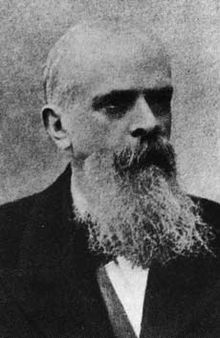Graziadio Isaia Ascoli
This article needs additional citations for verification. (May 2015) |
Graziadio Ascoli | |
|---|---|
 Graziadio Isaia Ascoli. | |
| Born | 16 July 1829 Gorizia, Austrian Empire |
| Died | 21 January 1907 (aged 77) Milan, Kingdom of Italy |
| Occupation | Linguist |
Graziadio Isaia Ascoli (16 July 1829[1] – 21 January 1907[2]) was an Italian[3] linguist.[4]
Life and work
Ascoli was born in an Italian-speaking Jewish family in the multiethnic town of Gorizia, then part of the Austrian Empire (now in Italy). Already as a boy, he learned some of the other languages traditionally spoken in the town, German, Friulian, Slovene and Venetian.
An autodidact, he published his first important work on the languages of the orient in 1854. In 1860, he was appointed professor of linguistics at the Accademia scientifico-letteraria in Milan and introduced the study of comparative philology, Romance studies, and Sanskrit.
He made an important contribution to the study of the relationship between Indo-European and Semitic and was pioneer in the fields of Romani language and Celtic languages.
In Italy, he is above all known for his studies of Italian dialects, which he was first to classify systematically. In the Italian language question (questione della lingua), he did not accept a standard language based on the Florentine dialect as proposed by Alessandro Manzoni, but argued for a levelling of the dialects.
He is founder of the so-called substratum theory, which explains the formation and development of languages as a result of interference with previous languages spoken by populations in question.
He died in Milan.
Political views
Ascoli considered himself foremost a Friulian of Jewish religion, but was also an Italian patriot. One of his most lasting and politically most influential contributions was the coinage of the geographical term Venezia Giulia to denote what was hitherto known as the Austrian Littoral. Ascoli suggested that northeast Italy was composed by three historically, geographically and culturally interconnected regions, which he called the Three Venices. According to his classification, these three historical-geographical regions were:
- Euganean Venetia (Venezia Euganea), comprising the Venetia region properly speaking (the current region of Veneto and Friuli);
- Tridentine Venetia (Venezia Tridentina), that is that part of the County of Tyrol that lied south of the Brenner Pass (corresponding to the current Italian region of Trentino-Alto Adige);
- Julian Venetia (Venezia Giulia), which was the area of the Austrian Littoral, plus the Hungarian port of Rijeka (Fiume).
Ascoli coined these names following the internal divisions in the Italy during ancient Roman rule, and applied them to the 19th century. His geographical redefinition had a strong political implication: it was aimed at showing that the peripheral areas of the Austrian Empire were in fact gravitating towards Italy. His denomination was soon taken over by Italian irredentist who sought for the annexation of the Trentino, the Austrian Littoral, Fiume and Dalmatia to Italy.
In World War I, the terms Venezia Giulia and Venezia Tridentina became the official denominations for the new territories acquired by Italy from Austria-Hungary with the treaties of Saint Germain and Rapallo. The Kingdom of Italy used Ascoli's terms to replace the previous traditional denominations, Tyrol and Austrian Littoral. The former term fell into disuse after the fall of the Fascist regime. The latter, however, is still exists in the name of the Italian region Friuli-Venezia Giulia. The term "Venezia Euganea", on the other hand, never gained any significant support, although it was sporadically used during the Fascist period.
Bibliography
Works published in Italian:
- G.I. Ascoli, La pasitelegrafia, Trieste, Tipografia del Lloyd Austraco, 1851[5][6]
- G.I. Ascoli, "Del nesso ario-semitico. Lettera al professore Adalberto Kuhn di Berlino”, Il Politecnico, vol. 21 (1864), pp. 190–216
- G.I. Ascoli, "Del nesso ario-semitico. lettera seconda al professore Francesco Bopp”, Il Politecnico, vol. 22 (1864) pp. 121–151
- G.I. Ascoli, "Studi ario-semitici", Memorie del Reale Istituto Lombardo, cl. II, vol. 10 (1867), pp. 1–36
- S. Morgana - A. Bianchi Robbiati (curr.), Graziadio Isaia Ascoli "milanese". Giornate di Studio. 28 Febbraio - 1 Marzo 2007, Milano, LED Edizioni Universitarie, 2009, ISBN 978-88-7916-415-3
References
- ^ [1], Graziadio Isaia Ascoli - Encyclopædia Britannica
- ^ [2], Archivio glottologico italiano : Ascoli, Graziadio Isaia, 1829–1907 ...
- ^ [3], Graziadio Isaia Ascoli - Wikiquote
- ^ [4], Autore:Graziadio Isaia Ascoli - Wikisource
- ^ [5], La pasitelegrafia - Graziadio Isaia Ascoli - Google Books
- ^ [6], La pasitelegrafia by Graziadio Isaia Ascoli | LibraryThing
External links
 Works by or about Graziadio Isaia Ascoli at Wikisource
Works by or about Graziadio Isaia Ascoli at Wikisource
